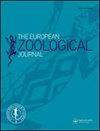综合分类学支持东南欧的一个而不是几个物种(昆虫纲,蜉蝣目,番荔枝科)
IF 1.4
4区 生物学
Q2 ZOOLOGY
引用次数: 2
摘要
摘要巴林根属(Palingenia Burmeister,1839)是一个小型但备受争议的mayflies属,因为其物种分类学存在争议。曾经在整个欧洲广泛分布的长尾巴林根(Palingenia longicoda,Olivier,1791),一个大型原始河流的标志性物种,已经失去了大部分原始范围,但其形态极大地阻碍了保护工作,其类似于同域的P.fuliginosa(Georgi,1802)和外域的P.sublongicoda Tshernova,1949。在对Soldán的原始藏品进行修订的基础上,补充了来自东南欧的新鲜材料,我们分析了213个成年雄性标本,这些标本来自目前已知的欧洲帕林根分布区的15个不同地点。基于阴茎形态和眼睛距离的形态测量结果的主成分分析(PCA)显示,被分析人群之间没有显著差异。此外,来自东南欧已知范围的帕林根属物种的73个个体的mtCOI条形码序列数据在基因上代表了高度相似的种群,没有分化。这些结果表明,欧洲东南部只有一个物种,即长尾P.longicoda,从而证明了该地区的P.fuliginosa的分布是错误的。亚长尾藻的分类地位仍然存疑,因为本研究没有该物种典型位点的模式材料或新鲜材料。强烈建议对Palingenia进行全面修订,包括来自亚洲和印度支那地区的其他物种,以重新评估Palingenias的物种组成,并检测欧洲单个长尾P.longiada最密切相关的分类群。本文章由计算机程序翻译,如有差异,请以英文原文为准。
Integrative taxonomy supports one rather than several species of Palingenia in South-Eastern Europe (Insecta, Ephemeroptera, Palingeniidae)
Abstract Palingenia Burmeister, 1839, is a small but intensively debated genus of mayflies due to the controversial taxonomy of the species belonging to it. Once widespread throughout Europe, Palingenia longicauda (Olivier, 1791), an iconic species of large pristine rivers, has lost most of its original range, but conservation efforts are greatly hampered by its morphology, which is similar to the sympatric P. fuliginosa (Georgi, 1802) and the peripatric P. sublongicauda Tshernova, 1949. Based on the revision of Soldán’s original collection, supplemented with fresh material from southeastern Europe, we analyzed 213 adult male specimens from 15 different locations from the presently known distribution area of Palingenia in Europe. Principal Component Analysis (PCA) based on the morphometry results of penis morphology and eye distances showed no significant differences among the analyzed populations. Further, the mtCOI barcode sequence data of 73 individuals from the known range of Palingenia species in southeastern Europe represented highly similar populations genetically, with no differentiation. These results show the presence of only one species in southeastern Europe, P. longicauda, thus disproving the distribution of P. fuliginosa in this region. The taxonomic status of P. sublongicauda remains doubtful, as no type material or fresh material from the locus typicus of the species was available for this study. A comprehensive revision of Palingenia, including additional species from Asia and the Indomalayan regions, is highly recommended to reevaluate the species composition of Palingenia and detect the most closely related taxa of the single P. longicauda in Europe.
求助全文
通过发布文献求助,成功后即可免费获取论文全文。
去求助
来源期刊

European Zoological Journal
Agricultural and Biological Sciences-Animal Science and Zoology
CiteScore
3.10
自引率
5.60%
发文量
80
审稿时长
30 weeks
期刊介绍:
The European Zoological Journal (previously Italian Journal of Zoology) is an open access journal devoted to the study of all aspects of basic, comparative and applied protozoan and animal biology at molecular, cellular, tissue, organ, organismal, population, and community-ecosystem level. Papers covering multiple levels of organization and integrative approaches to study animal form, function, development, ecology, evolution and systematics are welcome. First established in 1930 under the name of Il Bollettino di Zoologia, the journal now has an international focus, reflected through its global editorial board, and wide author and readership.
 求助内容:
求助内容: 应助结果提醒方式:
应助结果提醒方式:


